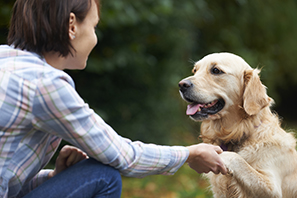Tricks to keep bad behaviour at bay

‘The benefits of training are huge,’ says behaviourist Claire Stallard from animal welfare charity Blue Cross. ‘Mental stimulation is very important.’ Indeed, trick training is likely to result in better overall health, helping to build muscle tone and stamina in your pet and improve his or her flexibility and balance.
Training should always be fun. ‘You should never use methods that intimidate or cause your pet pain or fear,’ says Clare. ‘Pets, like people, do not learn when they are stressed or frightened.’
Performing Pooches
Clicker training – where a device is used to make a sound that tells an animal when it is doing the right thing – is especially popular.
A retractable pen or vocal noise can be just as effective. Before you start training, teach your pet that a click equals a reward by clicking and giving a treat straightaway.
Dog trainer Karen Wild advises using plenty of rewards. ‘Having a clear goal in mind can help, too,’ she says, ‘such as deciding that you want your dog to wave a paw when you wave at him. But “free shaping” can also be fun: let the dog choose to do things, and if they are things you’d like him to repeat, click and treat him. It can lead to fun actions you’d never have expected.
‘I wouldn’t use shop-bought training treats,’ continues Karen. ‘I mix a bit of a dog’s usual kibble with tiny pieces of chicken or ham so as not to spoil their diet.’
Gina Stokes has been training dogs in agility and canine freestyle (performing in time to music) for almost 10 years. ‘My Border Collie knows many tricks,’ she says. ‘Her most unique is basketball. She will get the ball and stand on her hind legs to drop it in a mini basketball hoop. And my Welsh Sheepdog Cross knows how to jump a skipping rope with me.’
Stress-Busting Tricks
Teaching a pet to be happy being handled, get into their carrier willingly or sit still while having their nails clipped are all ways in which tricks can minimise stress. It’s often said that a well-trained dog is a happy dog and, providing that the tricks you choose are always based on natural behaviour, your dog will benefit greatly from training.
Teach you dog to shake hands
With your dog sitting in front of you, hold his paw for a second before clicking and treating. Repeat often in short sessions.
Now encourage him to lift his paw by tapping his leg gently or patting the floor in front of him. Click and treat even the slightest paw movement. Continue until he offers his paw each time.
Then add a cue word such as ‘shake’ just before lowering your hand. Once he reliably offers his paw on your cue word, gradually fade out the clicker and treats.

